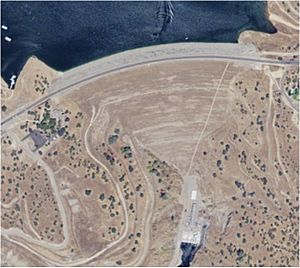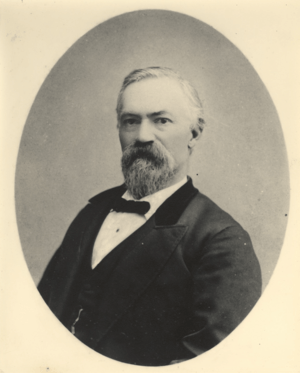New Don Pedro Dam facts for kids
Quick facts for kids New Don Pedro Dam |
|
|---|---|

Aerial view of New Don Pedro Dam
|
|
| Country | United States |
| Location | Tuolumne County, near La Grange, California |
| Coordinates | 37°41′58″N 120°25′15″W / 37.69944°N 120.42083°W |
| Construction began | 1967 |
| Opening date | 1971 |
| Owner(s) | Modesto Irrigation District and Turlock Irrigation District |
| Dam and spillways | |
| Type of dam | Embankment |
| Impounds | Tuolumne River |
| Height | 585 ft (178 m) |
| Length | 1,900 ft (580 m) |
| Elevation at crest | 855 ft (261 m) |
| Width (crest) | 40 ft (12 m) |
| Dam volume | 16,750,000 cu yd (12,810,000 m3) |
| Spillway type | Controlled overflow |
| Reservoir | |
| Creates | Lake Don Pedro |
| Total capacity | 2,030,000 acre⋅ft (2.50 km3) |
| Catchment area | 1,542 sq mi (3,990 km2) |
| Surface area | 12,960 acres (5,240 ha) |
| Normal elevation | 830 ft (250 m) (max) |
| Power station | |
| Hydraulic head | 560 ft (170 m) |
| Turbines | 3 x 55MW, 1 x 38MW Francis-type |
| Installed capacity | 203 MW |
| Annual generation | 552,381,000 KWh (2001–2012) |
The New Don Pedro Dam, often just called Don Pedro Dam, is a huge dam made of earth and rock. It crosses the Tuolumne River in Tuolumne County, California, near La Grange. This dam was finished in 1971 after four years of building. It replaced an older dam from 1924.
The dam's main jobs are to store water for farms, help prevent floods, and make electricity. It creates Lake Don Pedro in the foothills of the Sierra Nevada.
The Modesto Irrigation District (MID) and Turlock Irrigation District (TID) own and run the dam. It stands 585 feet (178 m) tall, making it one of the highest dams in the U.S. Its lake is the sixth largest artificial lake in California.
The dam was named after an old mining town called Don Pedros Bar. This town got its name from a gold prospector named Pierre "Don Pedro" Sainsevain.
Why Was the Dam Built?

In 1887, the Modesto and Turlock Irrigation Districts were formed. They needed water for their farms in the San Joaquin Valley. So, they got rights to use water from the Tuolumne River.
They built the first Don Pedro Dam, now called Old Don Pedro Dam, in 1921. It was finished in 1923. This dam was 284 feet (87 m) tall and was the highest dam in the world at that time. It created a lake that could hold 289,000 acre-feet (0.356 km3) of water. The dam also had a power plant that made electricity.
By the 1940s, people started thinking about building a bigger dam. The old dam could only store enough water for one year. Farmers worried about long droughts. A new, bigger dam would store more water for dry years and help control floods better. The city of San Francisco also wanted more water from the Tuolumne River. They decided to work with the irrigation districts to build the new dam.
Building the New Dam
In 1961, people in the dam's service areas and San Francisco voted to pay for a new dam. They hoped to finish it by 1966. But there were worries about how the dam would affect king salmon in the river. This caused delays.
Finally, in 1966, the Federal Power Commission gave permission to build the New Don Pedro Dam. The main building contract was given to Guy F. Atkinson Company in August 1967.
Workers started clearing the dam site right away. They also built roads and a camp for the workers. Construction of the dam's spillway began soon after. In September 1967, they started digging a tunnel to redirect the river. This tunnel was 3,415 feet (1,041 m) long and was finished by March 1968.
In September, a temporary dam called a cofferdam was built. The river then flowed through the diversion tunnel. This allowed workers to dig out the dam's foundations down to solid rock.
Building the main dam began in September 1968. They used a method called "hydraulic fill" to place the earth and rock. The huge concrete emergency spillway was completed in January 1969. However, a big flood in January destroyed the cofferdam and bridges, setting work back a month.
Workers quickly cleaned up. They started placing special material for the dam's core in February. For the next 15 months, huge dump trucks delivered dirt and rock constantly. The dam wall grew about 1+1⁄2 feet (0.46 m) each day. At its busiest, 500 men worked on the dam. The service spillway was finished in December 1969. On May 28, 1970, the dam was finally topped out. Over 250,000 truckloads of material were used.
Before the lake filled, over 7,000 acres (2,800 ha) of land was cleared. Roads that ran through the area were moved. The diversion tunnel was closed, and water began to fill behind the new dam. The rising lake covered the Old Don Pedro Dam on April 12, 1970. It also flooded the Gold Rush town of Jacksonville by June.
The power plant and large pipes (called penstocks) were finished by August 1970. There were delays because the generators, pipes, and gates were so big and heavy. Some parts were so heavy that a truck carrying one section sank into the road!
The total cost to build the New Don Pedro Dam was about $115.7 million. The dam was officially opened on May 22, 1971. Over 3,000 people attended the ceremony. Joseph Alioto, the mayor of San Francisco, gave a speech.
How the Dam Works
The New Don Pedro Dam is 585 feet (178 m) tall from its base and 560 feet (170 m) above the Tuolumne River. It's a massive structure made of earth and rock, containing 16,750,000 cubic yards (12,810,000 m3) of material. The dam is 1,900 feet (580 m) long and 40 feet (12 m) wide at the top. At its base, it's over 2,800 feet (850 m) wide.
Water releases are controlled by different gates.
- Internal gates in the diversion tunnel can release a lot of water.
- A special valve at the dam's base can also let water out.
- The service spillway has three large gates and can release huge amounts of water.
- The emergency spillway is a long concrete structure that can discharge even more water during extreme floods.
The power plant at the dam's base has four generators. Together, they can produce 203 MW of electricity. The Turlock Irrigation District gets most of this power (about 68%). The Modesto Irrigation District gets the rest (about 31%). Three generators were part of the original design. A fourth, smaller generator was added in 1989. The plant makes about 618.4 million kilowatt hours of electricity each year. This power helps supply the cities of Modesto and Turlock.
Lake Don Pedro can hold 2,030,000 acre-feet (2.50 km3) of water. About 340,000 acre-feet (0.42 km3) is kept for flood control. The rest is used for irrigation, city water, and making electricity. The dam's flood control space is smaller than other big California reservoirs. This means more water can be stored for power, but sometimes it's not enough to prevent floods. For example, in 1997, the dam had to release a lot of water, much more than downstream areas could handle.
The lowest point where water can be released to make power is called dead storage. This is about 309,000 acre-feet (0.381 km3) of water. When the lake is full (at 804 feet (245 m) elevation), it is 25 miles (40 km) long. It covers an area of 12,960 acres (5,240 ha) and has 160 miles (260 km) of shoreline. The highest the lake can get is 830 feet (250 m) above sea level.
During construction, people thought the lake would be a popular place for visitors. A plan was made to add campsites, picnic areas, boat ramps, and hiking trails. Don Pedro has become a popular summer spot in Central California. It attracts between 360,000 and 400,000 visitors every year.
Future Plans for the Dam
In 1923, the same year the Old Don Pedro Dam was finished, San Francisco built O'Shaughnessy Dam. This dam created a lake in the Hetch Hetchy Valley of the Tuolumne River. There's been a long debate about whether to remove O'Shaughnessy Dam.
Some people suggest making the New Don Pedro Dam taller to replace the water storage that would be lost if Hetch Hetchy Lake was drained. If New Don Pedro Dam was raised by just 20 feet (6.1 m), it would add about 360,000 acre-feet (0.44 km3) of storage. This would replace most of the water from Hetch Hetchy. However, new tunnels would be needed to move water from Don Pedro to the Hetch Hetchy Aqueduct. Also, less electricity would be made overall. San Francisco already has rights to some of the water stored in Don Pedro.
The Turlock Irrigation District is also looking into building a large pumped-storage hydroelectric plant at Lake Don Pedro. This would help meet electricity demands when power is needed most. The project, called Red Mountain Bar, would involve building another dam. This dam would create a new reservoir with a capacity of 25,000 to 42,000 acre-feet (0.031 to 0.052 km3). Water would be pumped into this new lake using power from New Don Pedro Dam when electricity demand is low. Then, when demand is high, water would be released to make 880 MW of power. As of 2011, this project was put on hold due to economic conditions.


